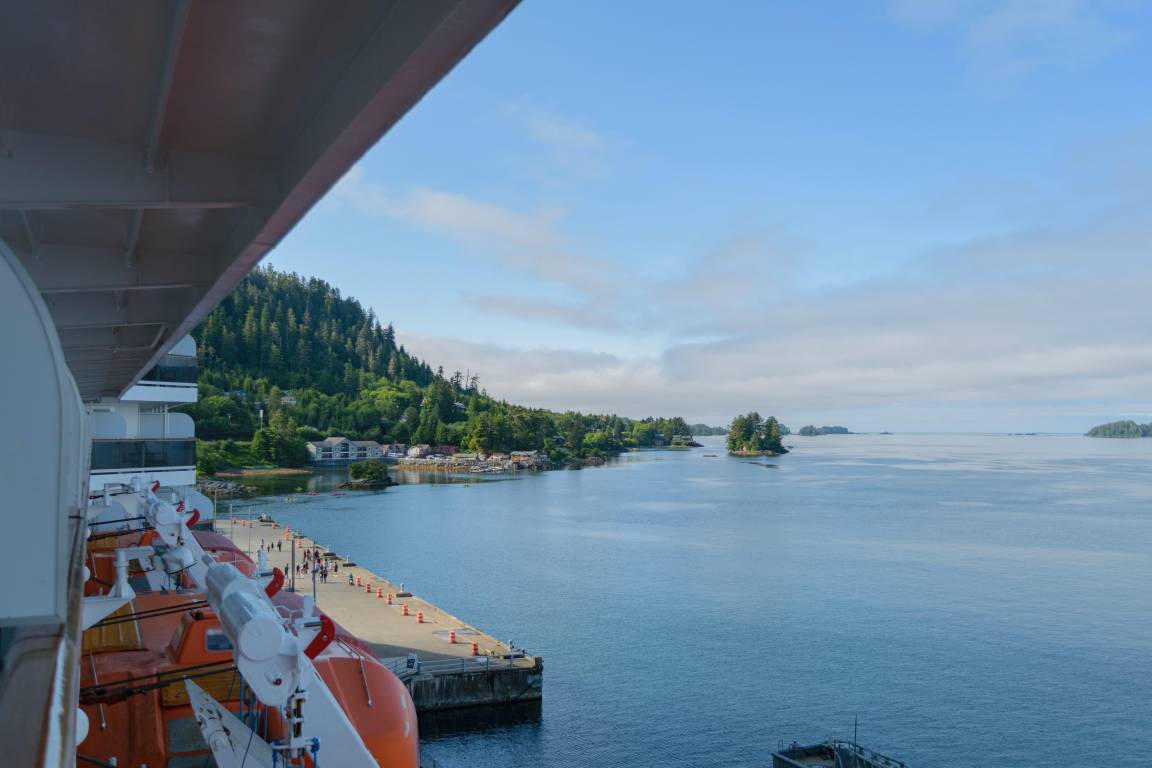Sitka offers Alaska cruise passengers direct access to 10,000 years of living Tlingit culture maintained by the Sheet'ká Kwáan community on Baranof Island. This former Russian capital layers Orthodox cathedral domes alongside ancient totem poles, where contemporary Tlingit carvers work within view of 1840s colonial architecture. The compact downtown and May-September extended daylight allow authentic cultural immersion during standard 7-9 hour port calls - if you know where to look beyond typical shore excursions.
Questions
What Is Your Favorite Type Of Cruise Excursion?
Planning Your Sitka Cultural Experience
Key considerations for authentic cultural immersion during your Alaska cruise port visit.
- Reserve shuttle transportation early - The Sitka Sound Cruise Terminal now requires advance shuttle reservations for the six-mile journey to downtown
- Allocate 2-3 hours minimum - Sitka National Historical Park's Totem Trail and cultural programming deserve unhurried attention
- Choose indigenous-operated tours - Sitka Tribal Tours ensures revenue directly supports Tlingit cultural preservation and language programs
- Visit during salmon season (July-September) - Witness the ecological relationships that shaped Tlingit culture for millennia
- Book your Alaska cruise with cultural discovery focus - Connect with Heather Hills at Flow Voyages for itineraries emphasizing authentic indigenous experiences
Article Index
- What makes Sitka different from every other Alaska cruise port
- Getting downtown: Why you need shuttle reservations now
- Sitka National Historical Park and totem traditions
- Russian Bishop's House and colonial architecture
- Naa Kahídi cultural performances and Tlingit clan houses
- Supporting authentic cultural preservation
- Timing and seasonal considerations
- How to make your port day count (and skip the tourist traps)
What makes Sitka different from every other Alaska cruise port
According to the Sitka Tribe of Alaska, Tlingit people have maintained a continuous presence in this region since the last ice age ended - one of the longest continuously inhabited places in North America.
This isn't heritage preserved in museums alone. Living culture expresses itself through language preservation programs, traditional governance systems, and active ceremonial practices.
The 1804 Battle of Sitka between Kiks.ádi Tlingit warriors and Russian colonial forces marked a pivotal moment in Alaska's history. Tlingit people returned to Sitka in 1821 and have maintained their cultural identity through periods of Russian control, American purchase, and ongoing challenges to indigenous sovereignty. While Sitka's population numbers only 8,400 residents, the indigenous community maintains robust cultural institutions including language programs, traditional dance groups, and master carver apprenticeship systems.
Getting downtown: Why you need shuttle reservations now
The Sitka Sound Cruise Terminal sits approximately six miles north of downtown on Halibut Point Road. As of 2025, cruise passengers must reserve complimentary shuttle times in advance - a system implemented to manage peak passenger volumes during the increasingly busy Alaska cruise season.
Passengers can find cruise excursions through ship-affiliated programs, though independent travelers should note that Sitka's walkable downtown layout facilitates self-guided cultural exploration once shuttles deliver passengers to Harrigan Centennial Hall.
The shuttle operates continuously while ships remain in port, with reservations available through the Sitka Sound Cruise Terminal website. Plan your return shuttle carefully - the reservation system uses specific time slots, not open boarding, which means you can't just show up whenever you're done exploring.
Sitka National Historical Park and totem traditions
Alaska's oldest federally designated park occupies 113 acres along the Indian River mouth where the 1804 battle occurred. This mile-long Totem Trail through coastal temperate rainforest showcases 18 Tlingit and Haida totem poles - both historical pieces and contemporary works that demonstrate continuing artistic traditions.
The poles serve multiple purposes within indigenous culture. They record clan histories. They commemorate individuals. They illustrate traditional stories that encode cultural values and ecological knowledge.
The park's Southeast Alaska Indian Cultural Center houses master carvers who maintain traditional tool techniques and design systems. Summer visitors can observe active carving projects while cultural educators explain the spiritual dimensions of this work.
Walking the forest trail during salmon spawning season (mid-July through September) adds ecological dimension to cultural understanding. The relationship between Tlingit communities and Pacific salmon runs shaped settlement patterns and resource management practices that sustained large populations for thousands of years before European contact.
Russian Bishop's House and colonial architecture
Built in 1841-43 from Sitka spruce by Tlingit workers under Finnish supervision, the Russian Bishop's House represents one of only four surviving examples of Russian colonial architecture in North America. The two-story log structure housed Bishop Innocent Veniaminov - a remarkable figure who learned Tlingit language, created the first Tlingit alphabet, and documented indigenous cultural practices while simultaneously working to convert communities to Russian Orthodox Christianity.
The National Park Service completed extensive restoration in the 1980s, returning the building to its 1850s appearance while installing modern climate control systems necessary for artifact preservation. Tours include the Bishop's residential quarters, chapel spaces, and schoolrooms that illustrate the complex cultural exchanges occurring during Russian America's governance from this location (1799-1867).
The building sits within walking distance of downtown along Lincoln Street. Its positioning shows the integration of Russian colonial power structures within existing Tlingit settlement patterns. St. Michael's Russian Orthodox Cathedral downtown - rebuilt after 1966 fire destroyed the original 1848 structure - completes this architectural narrative of cultural collision and adaptation.
Naa Kahídi cultural performances and Tlingit clan houses
The Sheet'ká Kwáan Naa Kahídi Community House provides the setting for Naa Kahídi Dancers. These Tlingit performers present traditional dance, song, and oral history within a contemporary interpretation of clan house architecture. The performances transmit cultural knowledge to both indigenous youth and non-Native audiences.
Box drum rhythms, cedar smoke, and regalia decorated with clan crests create sensory dimensions that written accounts cannot convey. Performances include explanation of clan systems, migration stories, and the role of oral tradition in preserving knowledge without written language. Each piece of regalia took months or years to create using traditional techniques, encoded with specific clan affiliations and family histories.
Supporting authentic cultural preservation
The Sitka Tribe operates its own tour company to ensure cultural programming directly benefits indigenous community members and supports language revitalization, youth education, and cultural preservation projects. Choosing Tribal Tours means tourism revenue supports the communities whose culture attracts visitors.
Downtown shops along Lincoln Street include Southeast Alaska Native Artists (SEANA) - a cooperative gallery featuring work by indigenous artists who maintain traditional techniques. Purchasing directly from indigenous artists supports cultural transmission by making traditional art economically viable. The Alaska Raptor Center demonstrates contemporary Tlingit relationships with wildlife species that hold cultural significance, adding dimension to understanding why certain animals carry weight in indigenous symbolic systems.
Timing and seasonal considerations
Alaska cruise season runs May through September, with peak volumes occurring June through August. In May 2025, Sitka voters rejected a ballot measure that would have capped daily passenger arrivals at 4,500 people, six days weekly. The cruise industry continues to work with the city on managing visitor volumes while supporting the local economy.
July and August bring salmon spawning throughout local streams, adding wildlife viewing opportunities to cultural programming. Extended daylight hours (17-18 hours in June and July) allow substantial exploration time during typical 7-9 hour port calls. September offers fewer crowds, comfortable temperatures, and early fall colors, with cultural programming continuing through the month.
How to make your port day count (and skip the tourist traps)
Don't let the small downtown fool you. Sitka, Alaska walkable end-to-end in under 30 minutes, but the cultural depth here takes days to fully appreciate.
Allocating time for ranger-led programs at Sitka National Historical Park, attending Naa Kahídi performances, and visiting the Russian Bishop's House creates fuller understanding of how multiple cultural influences shaped this unique place. The Sitka History Museum at Harrigan Centennial Hall provides useful context before visiting specific sites, with staff available to advise on current cultural programming and seasonal opportunities.
Treat Sitka as a learning opportunity, not a photo op, and you'll leave with actual understanding. The Tlingit community welcomes your curiosity while maintaining control over how their stories get told.
Thanks for reading. We hope this was helpful!
Why stop now?
Participate In Our Polls | Ask or Answer A Cruise Question | Contact Heather to Book Your Next Cruise!

